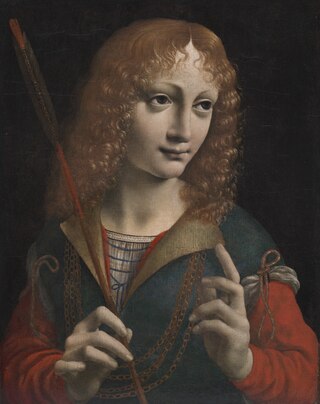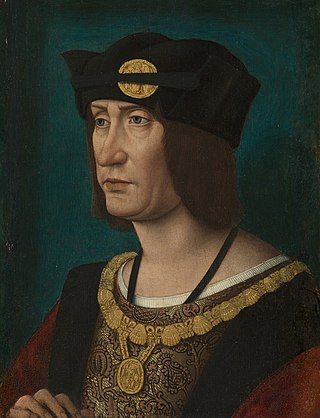Life
Master of ceremonies
Botta was born into a noble family of Pavia. His father's name was Giovanni and his brother Giacomo was the ambassador of the Duchy of Milan to the Holy See. A letter of the papal nunzio Giacomo Gherardi [ it ] indicates that Botta was one of Ludovico Sforza's protégés by 1489. In that year, he held a banquet in honour of the marriage of Duke Gian Galeazzo Sforza and Isabella of Aragon in his house in Tortona. The guests were entertained by a series of dances accompanying the courses of the meal. This is often considered a seminal event in the history of ballet, insofar as the whole event was choreographed under a common theme. The only contemporary account of this event is found in the work of Tristano Calco [ it ]. Calco presents Botta as a self-made man who had acquired his wealth through skill.
Treasurer
By 1491, Botta was working in the ducal financial administration under Ludovico's regency. He rose to become master of general revenue. After Ludovico became duke, Botta advocated highly unpopular policies for raising funds and was active in their collection in 1493–1494. Marino Sanuto the Younger records that when the nobleman Francesco Bernardino Visconti accused Ludovico of ruining the state with exactions, Botta came to the duke's defence. The chronicler Ambrogio da Paullo echoed Visconti in blaming Botta, in part, for the ruin of the state under Ludovico.
In 1499, as a French army approached Milan and with Ludovico having fled to Germany, Botta took refuge in the Castello Sforzesco. He favoured setting up a republic in Ludovico's absence to buy time. He was probably a party to the negotitations that surrendered the city to the French on 17 September. He left the castle the next day.
Under the French
After Ascanio Sforza seized power with popular support on 2 February 1500, the unpopular Botta was accused of plotting his assassination. According to Giovanni Andrea Prato, his palace was attacked by a violent mob of 4,000, but his sizeable guard, which he had begun assembling in August 1499, prevented looting. [4] He was arrested on 24 February 1500 and fined a large sum. He returned to favour with the return of the French governor, Gian Giacomo Trivulzio, in April. In 1502, he played a role in a failed French attempt on Bellinzona. That year, he married his daughter Apollonia to Filippo of the House of Borromeo, providing a dowry of 24,000 imperial lire . He died in Milan on 5 January 1504.
Botta's wealth and prestige are indicated by his daughter's marriage and dowry and his own ability to maintain an armed following. His second wife and widow, Madonna Daria Botta, hosted King Louis XII of France in her house in 1515 and was brought back to France by him as a valuable hostage in 1516. Botta also founded and endowed a college at the University of Pavia.

Francesco I Sforza was an Italian condottiero who founded the Sforza dynasty in the duchy of Milan, ruling as its (fourth) duke from 1450 until his death.

The House of Sforza was a ruling family of Renaissance Italy, based in Milan. Sforza rule began with the family's acquisition of the Duchy of Milan following the extinction of the Visconti family in the mid-15th century and ended with the death of the last member of the family's main branch, Francesco II Sforza, in 1535.

Vigevano is a comune (municipality) in the province of Pavia, in the Italian region of Lombardy. A historic art town, it is also renowned for shoemaking and is one of the main centres of Lomellina, a rice-growing agricultural district. Vigevano received the honorary title of city with a decree of Duke Francis II Sforza on 2 February 1532. It is famed for its Renaissance Piazza Ducale in the centre of the town. It is also known for the Rassegna Litteraria di Vigevano, an annual cultural event celebrating literature and the arts, which honours two distinguished personalities from the world of culture every year with the National Prize and the International Career Prize.

Ludovico Maria Sforza, also known as Ludovico il Moro, and called the "arbiter of Italy" by historian Francesco Guicciardini, was an Italian nobleman who ruled as the Duke of Milan from 1494 to 1499.

Cecilia Gallerani was the favourite and most celebrated of the many mistresses of Ludovico Sforza, known as Lodovico il Moro, Duke of Milan. She is best known as the subject of Leonardo da Vinci's painting The Lady with an Ermine. While posing for the painting, she invited Leonardo, who at the time was working as court artist for Sforza, to meetings at which Milanese intellectuals discussed philosophy and other subjects. Cecilia herself presided over these discussions.

The Visconti of Milan are a noble Italian family. They rose to power in Milan during the Middle Ages where they ruled from 1277 to 1447, initially as Lords then as Dukes, and several collateral branches still exist. The effective founder of the Visconti Lordship of Milan was the Archbishop Ottone, who wrested control of the city from the rival Della Torre family in 1277.

The Duchy of Milan was a state in Northern Italy, created in 1395 by Gian Galeazzo Visconti, then the lord of Milan, and a member of the important Visconti family, which had been ruling the city since 1277.

Galeazzo Maria Sforza was the fifth Duke of Milan from 1466 until 1476. He was notorious for being lustful, cruel, and tyrannical.

Caterina Sforza was an Italian noblewoman, the Countess of Forlì and Lady of Imola, firstly with her husband Girolamo Riario, and after his death as a regent of her son Ottaviano.

Isabella of Aragon, also known as Isabella of Naples, was by marriage Duchess of Milan and suo jure Duchess of Bari.

Gian Giacomo Trivulzio was an Italian aristocrat and condottiero who held several military commands during the Italian Wars.

The First Italian War, or Charles VIII's Italian War, was the opening phase of the Italian Wars. The war pitted Charles VIII of France, who had initial Milanese aid, against the Holy Roman Empire, Spain and an alliance of Italian powers led by Pope Alexander VI, known as the League of Venice.

The Italian Wars of 1499–1504 are divided into two connected, but distinct phases: the Second Italian War (1499–1501), sometimes known as Louis XII's Italian War, and the Third Italian War (1502–1504) or War over Naples. The first phase was fought for control of the Duchy of Milan by an alliance of Louis XII of France and the Republic of Venice against Ludovico Sforza, the second between Louis and Ferdinand II of Aragon for possession of the Kingdom of Naples.

Bianca Maria Visconti also known as Bianca Maria Sforza or Blanca Maria was Duchess of Milan from 1450 to 1468 by marriage to Francesco I Sforza. She was regent of Marche during the absence of her spouse in 1448. She served as Regent of the Duchy of Milan during the illness of her spouse in 1462, as well as in 1466, between the death of her spouse and until her son, the new Duke, who was absent, was able to return to Milan to assume power.

Gian Galeazzo Sforza, also known as Giovan Galeazzo Sforza, was the sixth Duke of Milan.

The House of Trivulzio is the name of an old Italian noble family, most closely associated with Milan, whose members were prominent politicians, military men and various clergymen, whose first members are recorded since the 10th century.

Galeazzo da Sanseverino, known as the son of Fortuna, was an Italian-French condottiere and Grand Écuyer de France; Marquis of Bobbio, Count of Caiazzo, Castel San Giovanni, Val Tidone and Voghera. He was first the favorite of Ludovico il Moro and Beatrice d'Este, then of Louis XII and Francis I of France, as well as a sworn enemy of Gian Giacomo Trivulzio.
On the other hand the Duke of Milan
called and gave the general cane
to Maria Galeazo, and captain
did it of his people on the saddle,
who riding then from hand to hand,
with the banner in the wind of the snake,
honor and glory of Lombardy,
with many great gentlemen in company.

Bernardino Corio was an Italian humanist and historian of the Renaissance. His Patria historia (1503), which traces the history of Milan from its remote origins to 1499, is the earliest scholarly study of Italian history to be written in Italian vernacular rather than Latin.

The Treaty of Blois (1499), signed on 9 February 1499, was a secret military alliance between Louis XII of France and the Republic of Venice, in which they agreed to a joint attack on the Duchy of Milan. In return, the Venetians were to receive part of the Duchy, while France also undertook to provide military assistance if Venice was attacked by the Ottoman Empire.


















